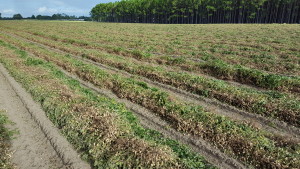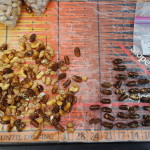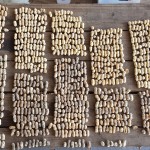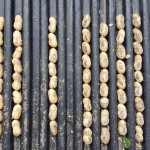 Peanut harvest was off to a good start in North Florida until our recent rain delay from Tropical Storm Hermine. In the meanwhile, we have been doing some maturity testing or “pod blasting” of our mid-April planted peanuts. These peanuts appear to be ready at about 135 after planting so far. Early harvest reports are of “good yields and good grades.” Farmers battling on simultaneous fronts; spraying and harvesting, haven’t had much time to study the numbers. We should be back going strong after the tropical storm clears out of the area. Peanut farmers monitor peanut maturity closely and try to harvest at the optimum time. Peanuts are an indeterminate plant, therefore they continue to flower and set fruit season long. Because individual peanuts darken as they mature, we can estimate when the majority of nuts on a vine, or in a field are at the optimum harvest stage.
Peanut harvest was off to a good start in North Florida until our recent rain delay from Tropical Storm Hermine. In the meanwhile, we have been doing some maturity testing or “pod blasting” of our mid-April planted peanuts. These peanuts appear to be ready at about 135 after planting so far. Early harvest reports are of “good yields and good grades.” Farmers battling on simultaneous fronts; spraying and harvesting, haven’t had much time to study the numbers. We should be back going strong after the tropical storm clears out of the area. Peanut farmers monitor peanut maturity closely and try to harvest at the optimum time. Peanuts are an indeterminate plant, therefore they continue to flower and set fruit season long. Because individual peanuts darken as they mature, we can estimate when the majority of nuts on a vine, or in a field are at the optimum harvest stage.
As we look at peanut maturity, it seems that farmers most often ask 3 question:
1) When will these peanuts be ready to dig?
2) Are these peanuts ready to dig? and
3) Is field A more ready than field B?
 The pod blasting and maturity board we use in Extension offers a good estimate of all of the above. Peanut pod blasters are used to strip away the outer pod layer to expose colors indicative of the stage of pod maturity. More information about the peanut pod blaster as developed by Dr. Jay Williams can be found HERE. The pods are placed on the maturity board developed by Williams and Drexler. Each of the methods require some experience with determining the different color categories: black, brown, orange, yellow, or white. The saddle area on the pod is where the color should be determined.
The pod blasting and maturity board we use in Extension offers a good estimate of all of the above. Peanut pod blasters are used to strip away the outer pod layer to expose colors indicative of the stage of pod maturity. More information about the peanut pod blaster as developed by Dr. Jay Williams can be found HERE. The pods are placed on the maturity board developed by Williams and Drexler. Each of the methods require some experience with determining the different color categories: black, brown, orange, yellow, or white. The saddle area on the pod is where the color should be determined.
 I often work with farmers using other strategies in their farm shops or on the tailgate of their truck. And those alternate methods can be equally valuable for getting the quick and easy answer to the above questions. I was recently in a farm shop with stacks of blasted peanuts. These were not arranged on a board, but were sorted by color and compared side by side. One important observation was using a standardized sample size, in this case a bowl or pan full of peanuts pulled off the vines. These methods can leave a little more room for interpretation, but it is a good comparison looking at the stacks side by side.
I often work with farmers using other strategies in their farm shops or on the tailgate of their truck. And those alternate methods can be equally valuable for getting the quick and easy answer to the above questions. I was recently in a farm shop with stacks of blasted peanuts. These were not arranged on a board, but were sorted by color and compared side by side. One important observation was using a standardized sample size, in this case a bowl or pan full of peanuts pulled off the vines. These methods can leave a little more room for interpretation, but it is a good comparison looking at the stacks side by side.
 Another method I frequently employ in a crunch is the pocketknife hull-scrape. This can be a quick determination and one I find most valuable for grabbing some baseline data on maturity. It is easy to pull up a hill of peanuts and check them on the tailgate, compared to the equipment and workspace needed to lay peanuts on a maturity board. However the output, or value of information is reflective of the low input. However, it remains a valuable tool in the toolbox as we approach harvesting. I like to scrape about 100 peanuts, and look for about 80% black and brown as we approach harvest.
Another method I frequently employ in a crunch is the pocketknife hull-scrape. This can be a quick determination and one I find most valuable for grabbing some baseline data on maturity. It is easy to pull up a hill of peanuts and check them on the tailgate, compared to the equipment and workspace needed to lay peanuts on a maturity board. However the output, or value of information is reflective of the low input. However, it remains a valuable tool in the toolbox as we approach harvesting. I like to scrape about 100 peanuts, and look for about 80% black and brown as we approach harvest.
I will continue to pod blast at the Columbia County Extension Office on Tuesday mornings throughout the peanut harvest season. Let me know if you need help to check your peanut samples.
